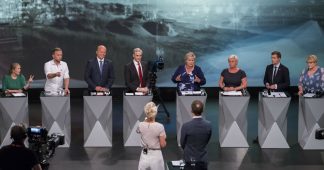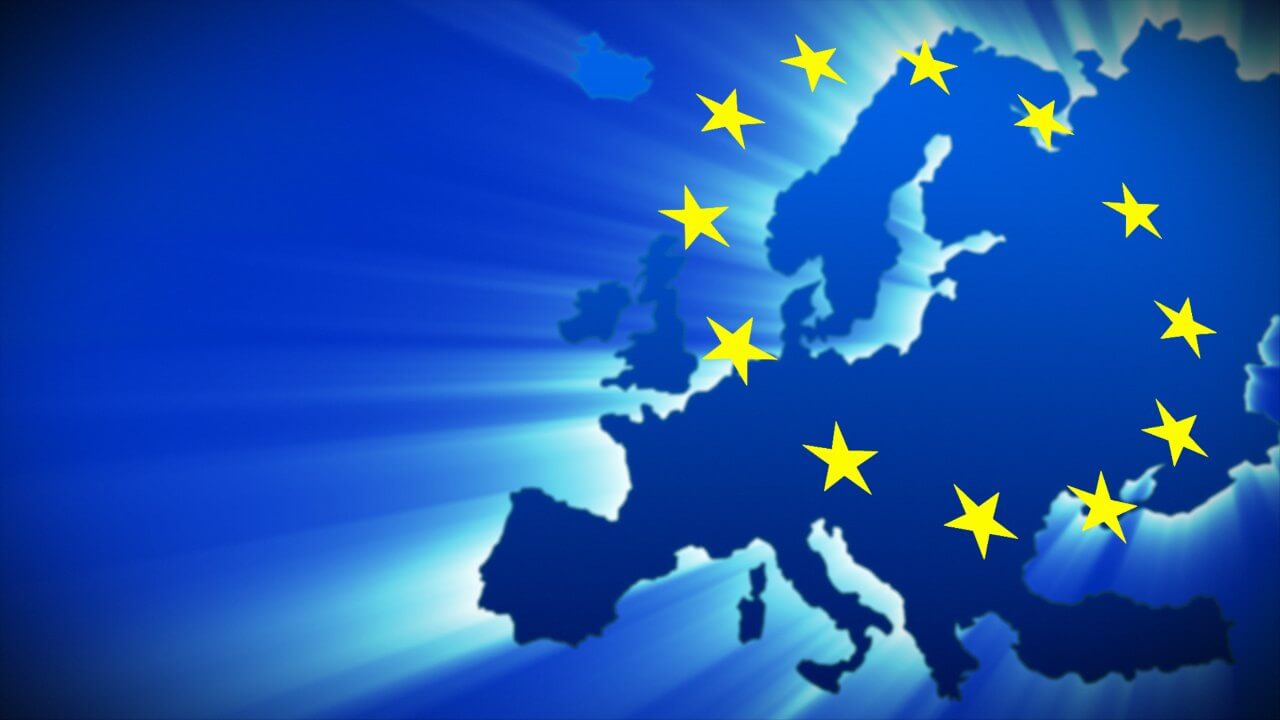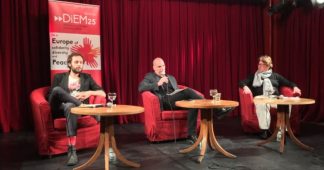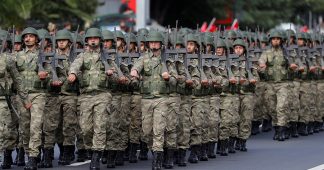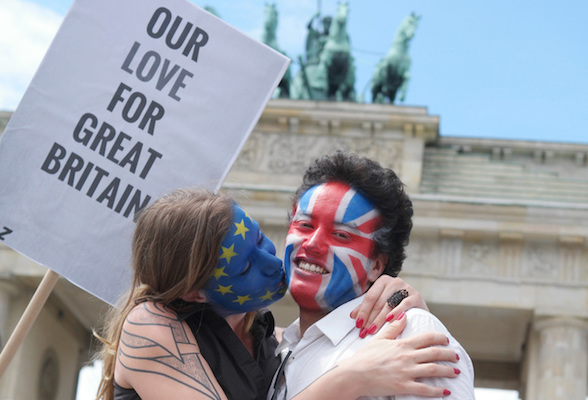This report is meant as a short introduction to the EU debate in Norway: its historical basis, contentious issues, as well as the positions of political parties and social groups, particularly those on the political left. It also gives a general account of recent political and economic developments in Norway, with special emphasis given to the 2017 parliamentary election.
The report was written and compiled by Attac Norway’s working group on Europe. We thank Asbjørn Wahl for allowing us to use his analysis of the recent parliamentary election as part of the report.
The European question in Norwegian political history
Idar Helle
In his works of political sociology Stein Rokkan underlined a set of political cleavages that in his view had dominated the societies in Western Europe up until the mid-20th century: Political centre vs periphery, religion, urban vs rural interests and finally, from the industrial age, the question of social class.[i] Among these cleavages our suggestion would be that the class issue and the conflict centre vs periphery was most apparent when it came to contentious politics and mobilization of popular protest in Norway after 1945. In particular, through the broad social mobilization and coalition building around the referendum on the membership in the European Community (1972), and then on the membership in the European Union (1994).
Like no other political campaigns linked to the European question, the ”No to EU” campaigns in Norway have defeated the political elites in referendums and denied ”ever closer union”. Even more significantly, Norway is the only country where the no-campaigns have managed to reject EU membership, and two times in 1972 and 1994.
Why was this possible? What created the necessary room of manoeuvre for the campaigns against EU membership? Our suggestion is that the change of the ordinary constitutional rules, that a referendum and not a qualified majority vote (2/3 or ¾) in the parliament was chosen to decide the question, opened a window of possibilities that no other forces of contention outside parliamentary politics have experienced in Norwegian politics in this era. Looking back on these events, Kristen Nygaard, president of the No to EU campaign organization in 1994, gives a hint on how this “no” movement was forged.
“In the early days, a meeting was successful if 15-20 people showed up. Discussing, conveying, and incorporating No-strategy was no problem. It took place at meeting after meeting. The local, and sometimes even the regional press, covered these events loyally. They could convey to the capital that people from the leadership of Nei til EU once again had held one of their tiresome lectures, once again with nothing new on the agenda. The same slides showing unemployment, judgements from the EEC Court, dry paragraphs from the Treaty of Rome or Maastricht (…) From these reports, no one could understand what really went on: The building of the largest political organization in Norway. The discussions late into the night after the meetings and the conversations between local key members never made it to the papers, neither did the countless meetings of local executive committees, board meetings, study groups, contacts between important organizations etc.”[ii]
For a contemporary observer of Cold War politics in Europe, especially the Norwegian no-vote in 1972 must have seemed to be against all odds. In the original six EC countries, the political forces on the left and right wings that were against the Rome Treaty and the foundation of the Common Market, were not able to connect and build sustainable alliances with social groups and economic interests that could turn the tables against the elite project of European economic integration. If we go to the labour movement for benchmarking, up until the mid 1970’s mighty union confederations like the CGT in France, the CGIL in Italy and the TUC in the UK were more critical of the EC politics than the top level of LO and the Norwegian labour movement. But they were not part of any broader centre to left and cross-party alliances that were strong enough to challenge the supporters of further economic integration.
In Norway, the situation was quite different. The no-movement could mobilize along several of the axes mentioned by Rokkan. Especially important were the alliances between the parties and youth parties on the left, important trade union and farmers organisations and their financially important agro-industrial complex.[iii] These red-green alliances from the two EU referendum campaigns in 1972 and 1994 did in fact get an after-life later on with the three party government formed by Arbeiderpartiet, the Sosialistisk Venstreparti and the rural agrarian Senterpartiet that lasted eight years (2005-13). In the same way as this alliance was built from below through common trust and belief in stronger public welfare, it was gradually broken down from the top by the central party apparatus of the three parties and a lack of will for structural reforms away from market capitalism.
This highlights a critical question of the progressive no to EU-movement in Norway and social movements in general: Their ability to win important battles – but not able to build a counter hegemony like the national-liberal Venstre movement from the 1870s and the labour movement after 1935.
[i] Rokkan 1987, pp. 267-380.
[ii] Nygaard 1995.
[iii] Seierstad 2014.
Norwegian elections: Another right-wing victory – and a serious Labour defeat
Asbjørn Wahl, Norwegian trade union and political activist
The centre-left failed in getting rid of the so-called blue-blue government at the parliamentary elections in Norway on 11 September. The Labour Party was the main loser, while small parties on the centre-left advanced slightly. However, the parliamentary basis of the right-wing government has started to unravel. A deeper political crisis may be looming in the background, while social contradictions are on the raise. Social Democracy followed the general European downward tendency (except Britain).
First, some basic facts on the Norwegian electoral system. There are 169 members of parliament, who are elected through proportional representation. The 19 counties serve as the electoral constituencies. There is a threshold of 4 percent to qualify for the proportional distribution of representatives, although it is possible to win direct representation from the counties also if the national gain of votes is below the threshold. Two political parties won representation in that way.
In the previous four-year parliamentary period, Norway was governed by a minority government formed by the Conservative Party and the so-called Progress Party (a right-wing populist party). Therefor the name blue-blue government. It was supported by two other parties – the Christian Democratic Party and the so-called Liberal Party (which in reality is neo-liberal, but with a touch of green). This support was established through a formal agreement, but to secure a parliamentary majority for the government, it was sufficient with support from only one of those two parties.
Norway has seen an increasing political fragmentation over the last years. After the current elections, there are nine political parties in Parliament. The four on the right are mentioned above, while the centre-left opposition includes the Labour Party, the Centre Party, the Socialist Left Party, the Green Party and the Red Party. As in many other countries, however, the entire political spectre has moved to the right during the neoliberal offensive from around 1980.
For the blue-blue government, two important things changed with the last election. The Christian Democratic Party says that it is no longer willing to sign a contract of support to a government in which the right-wing populist party takes part; and the government is dependent on both the two former supportive parties to achieve majority in Parliament. In other words, the Government’s political basis is much weaker than in the previous period, something that opens the possibility of a breakdown of the blue-blue government. Since Norway does not have the possibility to call an election in a mid-parliamentary period, this can lead to a lot of political turbulence or an open political crisis.
Many people expected a centre-left victory at this election, since the blue-blue government had carried out many unpopular policies. The discontent was particularly strong in the trade union movement. However, the Labour Party’s election campaign proved to be quite disastrous under its new leader, Jonas Gahr Støre. One of the big “mistakes” was a flirt with the so-called political centre (centre right), that is with the two political parties which had supported the blue-blue government and by that had also supported attacks on the labour law and other economic and social gains for the working class. Further, the Labour Party was not even able to take a clear stand against the on-going and very unpopular commercialisation of core services in the Norwegian welfare state. Neither did the party come up with a credible policy against the undermining of labour market regulations, which to a high degree is promoted by the increasingly authoritarian, neoliberal European Union. This is a policy that is being implemented in Norway through the European Economic Area (EEA), an agreement that is strongly supported by the Labour Party.
The right-wing populist party, on the other hand, was successful in setting the agenda for much of the election campaign, first and foremost by playing the anti-immigration card and by focusing on identity policies. The Labour Party was unable to respond to this with the only measures that can really confront such right-wing policies, namely a clear class policy. This did not necessarily happen because the party’s leadership is unwilling to do so, but simply because class politics are strongly in deficit in today’s social democracy – deeply rooted as it still is in a social partnership ideology.
While social democracy is on the verge of breaking down, and even being eradicated, in big parts of Europe today (Greece, Iceland, Ireland, the Netherlands, France), much suggests that also the Norwegian, actually the Nordic, social democracy, despite its fame as the creator of the Nordic welfare model, is now following the downward course of their European sister parties, although more gradually. Power relations does not seem to be part of the actual social democratic narrative – their ‘raison de vivre’ is obviously to administer capitalism within the limits given in the at any time existing power relations – not to shift the balance of power. Thus, the right-wing political offensive is not really being confronted by social democracy.
The golden age of social democracy was based on a class compromise and a balance of power which made it possible to move forward socially within the framework of a regulated capitalism (i.e. the welfare state). The material basis for such policies is now coming to an end with the deep crisis and stagnation of capitalism, and the subsequent neo-liberal offensive. The social democratic attempt to re-establish the class compromise, with its successful tripartite cooperation and social dialogue, even without class mobilisation and confrontations, is an illusionary project in the current political conjuncture.
Maybe the Norwegian election is just another sign that the era of social democracy is now coming to an end. All those, all over the world, who has been looking at the Nordic Model as their final aim, may have to rethink and reassess their policies and strategies. But who on the left is it that can now provide us with a class policy with perspective?
Norwegian parliamentary election in figures
| Party | Percentage votes | Gains/loss from last election | Number of MPs |
| The right-wing coalition: | |||
| The Conservative Party | 25.0 | -1.8 | 45 |
| The Progress Party | 15.2 | -1.2 | 27 |
| The Liberal Party | 4.4 | -0.9 | 8 |
| The Christian Democratic Party | 4.2 | -1.4 | 8 |
| The centre-left opposition: | |||
| The Labour Party | 27.4 | -3.5 | 49 |
| The Centre Party | 10.3 | +4.8 | 19 |
| The Socialist Left Party | 6.0 | +1.9 | 11 |
| The Green Party | 3.2 | +0.4 | 1 |
| The Red Party | 2.4 | +1.3 | 1 |
The EU in Norwegian politics
Sondre Molteberg Dalen, Mikkel Broen and Einar Hagness
In recent years, the prospect of membership in the European Union has become increasingly unpopular in the public at large, so proponents rarely push the issue in an active way. Since full membership is generally regarded as being off the table, the Norwegian EU debate is mostly focused on Norway’s participation in the European Economic Area (EEA), which lets the country participate in the single market without being a full member, while also obliging it to implement most of the legislation related to the market (with the notable exception of agriculture and fisheries). These laws are often imported without much public debate, except in a few controversial cases such as the Data retention directive or the Third postal directive.
Both of Norway’s two biggest parties, the Labour party and the Conservative party, have traditionally been among the main supporters of Norwegian accession to the EU, although the grassroots membership of both parties has generally been less enthusiastic than the leadership. Since the Norwegian Labour party still has relatively strong institutional connections with trade unions, it will be interesting to see how they respond to their growing discontent with the EEA. Despite still having the support of leaders in the four national trade union confederations, the agreement has become deeply unpopular among many representatives in the labour movement because of the large-scale social dumping practices it has facilitated in several sectors, particularly through the Temp agency directive. This has led to a debate about whether to regulate the migration by withdrawing from the EEA, or by strengthening the international fight against social dumping. LO, the trade union confederation that organizes the majority of industrial workers in Norway, has passed a resolution urging Norwegian authorities to utilise the room for action in the agreement rather than resigning it altogether. This would entail vetoing the introduction of hostile employment laws, and supporting the trade unions’ positions in disputes where collective agreements are weighed against free enterprise.
The right-wing populist Progress party is Norway’s third largest party, receiving 15 % of the votes in the recent election. The party has generally kept a low profile concerning EU-related issues, although they recently moved in a slightly more eurosceptic direction by advocating for a renegotiation of the EEA-agreement. All other parties represented in the Norwegian parliament generally take a skeptical view of the EU to varying degrees, although only the two left-wing parties and the agrarian Centre party go as far as supporting a withdrawal from the EEA.
The Socialist left party and the Red party constitute the left wing of Norwegian party politics. Compared to other parties of the European left, they have always been strongly skeptical of the EU, and the idea that it might be reformed along broadly progressive lines has never gained much traction among within them. Instead, they see increased national sovereignty combined with closer cooperation between the Nordic countries as the way forward. Both parties support withdrawal from the EEA, the closest equivalent to a left exit in a Norwegian context. However, there are also voices on the Norwegian left that worry about the increasing focus on national sovereignty. They raise the question if it really is possible to promote a progressive nationalism without legitimizing the chauvinistic nationalism of the right-wing populists, and claim that you cannot debate self-determination without simultaneously stressing the necessity of supranationalism. Their immediate resistance to the EU’s neoliberalism is rather focused on regulating financial industry and multinational companies, than limiting people’s freedom to seek jobs across the borders.
The 2017 election resulted in a continued parliamentary majority for the Conservative-led “Blue-Blue” government and their supporting parties, despite all of them losing seats. This was mainly due to a particularly bad showing by the Labor party, for which the gains made by other opposition parties could not compensate. The rural-based Centre party received the largest increase in vote share. Though they are generally the party most associated with opposition to the EU, their election campaign was mainly directed against the ongoing local administration reform and the government’s use of force to merge municipal authorities. As such, criticism of the EEA was tabled most forcefully by the left-wing parties. Overall though, questions related to the EU did not play a significant role in the election campaign.
Economic developments
by Petter Håndlykken and Sten Holth
Norway has a significant oil service and oil exploration industry. As oil prices dropped from the end of 2014, investments in the oil sector fell dramatically worldwide, forcing the oil companies to cut their costs. This led to a crisis of high unemployment in the areas of Norway most dependent on the oil industry. The government responded to the crisis through a combination of cutting interest rates, reducing the value of the currency, increasing the public spending in the construction sector and cutting taxes, especially for the rich. In order to finance this policy, the government has used an unprecedented amount of the yields generated by the so-called Oil fund, a sovereign wealth fund comprised of surplus revenues from the petroleum sector. These incomes are now financing appr. 17 % of government expenses, thus making Norway’s public finances even more dependent on the oil sector. The Labor Party based its election campaign on the insufficiencies of this policy. However in the months leading up to the election there was a drop in unemployment that seemed to indicate that the economy was recovering, which no doubt helped the Conservative government retain its hold on parliament.
Declining investments in the oil sector have been compensated to a certain extent by increased activity in the construction industry related to housing. Housing prices and private debt has increased precipitously in the last few years, which has led many to speculate on the possibility that we might be in a housing bubble. The prices of housing rose, with increasing investments in that sector, and we now seem to be in a housing bubble that is about to lose some air.
Norways’ international relations
by Petter Slaatrem Titland
The Foreign Ministry under the former minister Børge Brende (2013-2017) has been unprecedented in its weak links to the Norwegian civil society. Like many western countries, the government has changed its policy towards the World Trade Organization by entering negotiations on the megaregional Trade in Services Agreement (TiSA). This has marked a shift away from a cornerstone in Norwegian trade policy, which always has been to support the WTO. Norway have also been supporting the developing countries in the WTO, like the withdrawal of important public services from negotiations in earlier rounds in the WTO.
Due to the Nobel Peace Prize to Liu Xiaobo in 2011, China cut off all political ties to Norway. This year the foreign minister presented an agreement on the “normalization” of the relationship to China, which included an agreement on fish exports. Norway also agreed to “respect China’s political system”. This has led to the government not being able to criticize China on human rights abuses, although the foreign minister claims that these concerns are raised in conversations with the Chinese government.
In relation to the UN Norway has not supported the working group on the new UN Treaty for businesses and human rights. After two years of neglecting the process in the UN Human Rights Council, Norway is now an observer in the work along with the EU. Like other NATO countries, Norway has refused to support the UN Treaty on the prohibition of nuclear weapons.
In 2016 there was issued an independent public assessment of Norway’s participation in the war in Afghanistan. The report concluded that the Norwegian engagement had been ill advised, with shifting rationales and a lack of planning for withdrawal. The foreign minister rejected these criticisms.
Norway is not a part of the TTIP or CETA agreement, but has been one of the driving forces in the TiSA negotiations because of the developed service economy in Norway, especially in finance, energy and shipping. However, Norway are not in a position to influence the EU and the US, and the negotiations are currently stalled because of disagreements on the data flow of sensitive information.
The re-elected government are expected to further the expansion of investor-state dispute settlements in investment agreements. The government has also voiced their support for the new Multinational Investment Court proposed by the EU. Former foreign minister Børge Brende was recently announced as the new president of the World Economic Forum.
Published at http://lexit-network.org/the-eu-debate-in-norway-left-positions-and-recent-developments#more-1565
